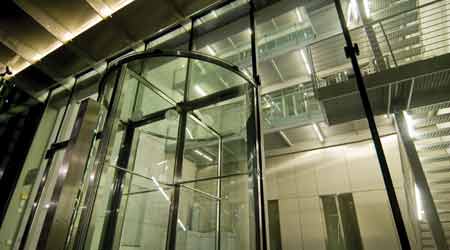 To achieve both safety and security goals, facility managers need to understand a range of factors, from traffic patterns to building codes.
To achieve both safety and security goals, facility managers need to understand a range of factors, from traffic patterns to building codes.Door Hardware Selection Must Consider Occupant Safety and Security
Safety and security are not mutually exclusive — but finding the balance between the two can often be challenging.
When considering issues of safety and security for their buildings, some facility managers have a sense that the two are mutually exclusive. This is particularly true when they are evaluating options concerning door hardware. Steps taken to improve the security of the installation are perceived as being directly detrimental to the safety of the building occupants. And measures adopted to enhance safety are thought to have a negative effect on overall building security. For them, it is a no-win situation.
In reality, there is a way to achieve a balance between life safety and security. It comes from first developing an understanding of doors and hardware, code requirements, and what the real security requirements are of the application. It also involves development of construction or renovation specifications, and continues throughout the life of the facility in the form of regular inspections, good maintenance practices, and education of building occupants.
There is no one-size-fits-all plan. To achieve both safety and security, a facility manager needs to understand how the facility is operated and how door security will affect those operations. Each building, and the operations it supports, is different. Plans must be tailored to the specific needs of the facility.
Facility operations
When considering safety and security concerns, most facility managers focus their attention on the exterior of the building. But a complete evaluation of safety and security needs must also take into consideration interior aspects, such as the compartmentalization of areas for both fire safety and security of occupants and contents of those areas. Facility managers must evaluate all areas for the most suitable path of the egress in the event of an emergency.
Start with the floor plan. Not all spaces will have the same security requirements. In some areas, the goal is to protect people; in others, it is to protect things. Thus, the overriding security concern might be to keep unauthorized people out of one area, while in other spaces the priority might be to keep inventory or equipment in. Not all door hardware components are equally good at accomplishing both tasks.
The security evaluation must also take into consideration on a location-by-location basis both the likelihood of a security breach and its potential consequences.
The floor plan can also help facility managers lay out the traffic patterns within the building. In general, those traffic patterns should make it easy for building occupants and visitors to get to the areas where they need to go while denying them access to areas where they are not supposed to go. By selecting door hardware to support these requirements, security will be enhanced, and the flow of traffic in the building will be improved.
The floor plan is also critical in laying out the best means of egress from all areas of the facility. Means of egress and traffic patterns are completely separate issues. Traffic patterns are designed to move people where facility managers want them to go. Means of egress are designed to get people out of the building as quickly and directly as possible in the event of an emergency. Door hardware must be selected based on which function is being considered.
Duty selection
Once the layout of the facility is understood, facility managers must determine the expected level of traffic through various areas within the building. Door hardware is rated based on the service duty it is expected to endure. The Builders Hardware and Manufacturers Association (BHMA) has established a rating system for door hardware based on testing procedures in various American National Standards Institute (ANSI) standards.
Components with a Grade 1 rating are considered to be heavy duty devices and are capable of withstanding 500,000 opening and closing cycles. Grade 2 devices must withstand 250,000 cycles. Grade 3 devices are used primarily in residential applications.
In general, the higher the rating of the door hardware, the more expensive it is. From a maintenance standpoint, it would be nice to use Grade 1 hardware everywhere. There would be no concern for it wearing out in low-use applications, and standardizing on its use would limit the range of spare parts that must be kept on hand.
But Grade 1 hardware costs between 25 percent and 50 percent more than comparable Grade 2 components. There are many applications within facilities where Grade 1 hardware isn’t needed. For that reason, facility managers are better off to match the grade of the hardware to the requirements of the application.
Fail-safe vs. fail-secure
Electromechanical locksets have gained widespread application in facilities as the result of the use of card readers and keypads. There are two basic types of these locksets: fail-safe and fail-secure. Building codes will dictate which type of device is to be used in which application.
Fail-safe products are those that use power to lock the door. As long as power is applied, the door remains locked. If the power should fail, the door is no longer locked. Fail-safe devices are typically installed on stairwell doors that provide re-entry. Fail-safe locks must be connected to the building’s fire alarm system so that doors can be unlocked in the event of a fire.
Fail-secure devices are the opposite. These devices remain in the locked position until power is applied. In the event of a power failure, the devices will remain locked. For this reason, fail-secure devices are more commonly used.
Related Topics:













